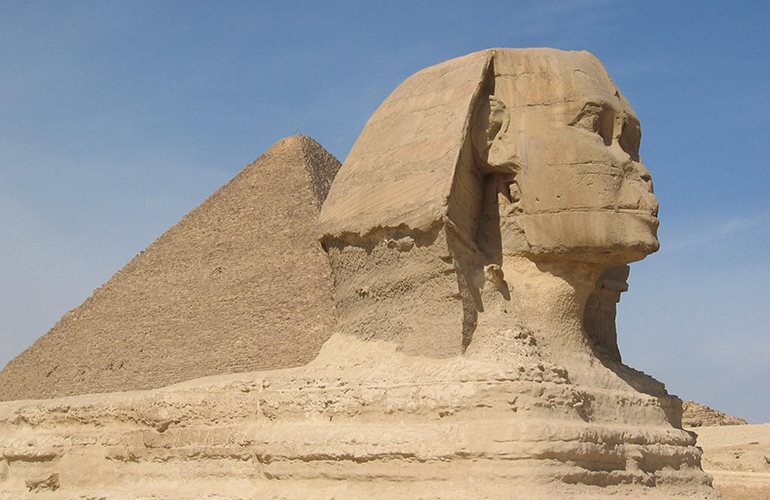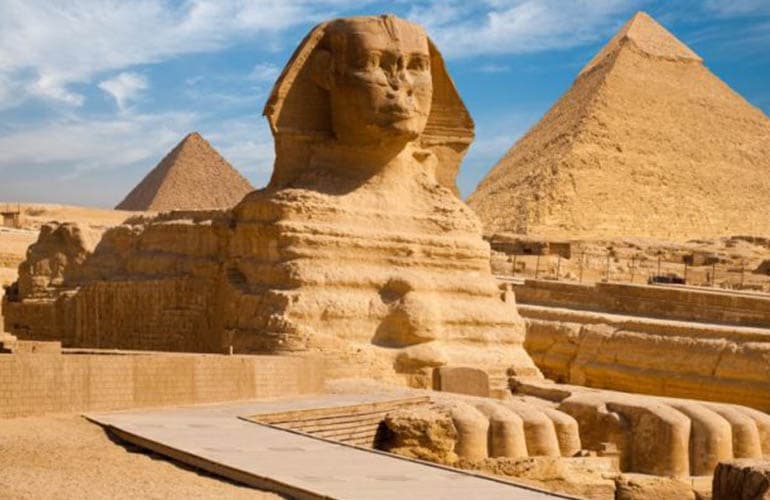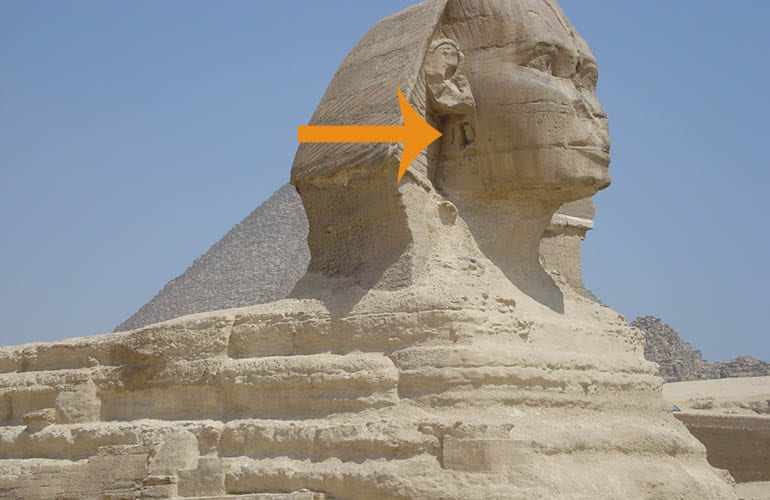The Great Sphinx of Giza facts:

The Great Sphinx of Giza is one of the most emblematic sculptures in the world. It is a monumental sculpture located on the west bank of the Nile River in the city of Giza, about twenty kilometers southwest of downtown Cairo.
The Great Sphinx of Giza, which is instantly associated with everything related to Ancient Egypt. The iconic monument, as you may know, is made up of a mythological creature with the body of a reclining lion and the head of a person, more specifically that of King Khafra of the Old Kingdom of Egypt (4th Dynasty). The epithet given by the Egyptians to the Sphinx was shesep ankh “living image”.
The Great Sphinx was made by sculpting a limestone mound on the Giza Plateau. It is 57 meters long and almost 20 meters high, built in a single block of natural rock, measuring more than five meters in the face. The head could represent the Pharaoh Khafra, a fact that is not yet certain, because it is possible that it was built by a minor pharaoh, prior to Khafra, having the body in the shape of a Lion. In ancient times it was painted in bright colors: red on the body and face, and the nemes that covered the head with yellow and blue stripes.
There is another theory that states that the original face of this statue was not primarily of a human being but in fact was of God Anubis when originally carved, and the face was later changed.
building the Sphinx, The three pyramids were built as a tomb to protect the king’s body and to preserve the supplies he would need in the afterlife from thieves, and it was also believed that his construction was pointed at the top of the pyramid, as a starting point for the king’s spirit to ascend to heaven and join the sun god.
What does the Sphinx mean?
we are in front of Ancient Egypt History, the magnificence of which lies not only in the beauty of its sculptures or its solidity with time, but its genius lies in the underlying secret behind it and in the myths that have been woven around it. So, let’s get acquainted with many information about the crouching lion before the gates of history.
The Egyptian name for the Great Sphinx is still unknown. The word “sphinx” is Greek and literally means “strangler,” in which lies a reference to the famous myth about the enigma of the Sphinx. The view that this word came to Greece from ancient Egypt is unfounded. In Arabic, it was called Abu Al Hol (Father of Terror).
Most of the ancient civilizations saw the lion as one of the symbols of the solar deity. Since ancient times it was customary to portray the pharaoh with lion attributes exterminating his enemies. In the light of these facts, it is permissible to consider the Sphinx as a guardian of the eternal rest of the pharaohs buried around it.
The nearby temples were originally dedicated to the sun god Ra, and during the New Empire, the sculpture was identified with an apparition of the god Horus: “Horus on the Horizon” (Haremakhet); Amenhotep II (Pharaoh of the 18th dynasty of Egypt) would build another temple to this god to the northeast of the Sphinx.

The secret chamber of the Great Sphinx
It is true, there is a secret chamber (more than secret, hidden) under the statue. It is often thought that there are more spaces inside or underneath because the ancient texts mention a secret chamber, called “The Temples of Thoth”, where the knowledge of antiquity would have been preserved.
Romans and Arabs also believed that there were secret spaces under the statue and no doubt they tried to find them. During an excavation in the 1980s, a tunnel was discovered in the northern area, but it ended up in an empty cavity. So far there is no indication that the famous archive room is anything more than a legend.
Between 1816 and 1818 Captain Giovanni Battista Caviglia was in charge of digging up the Sphinx and the temples surrounding it. Its proximity to the Pyramid of Khafra was immediately more than enough reason to associate its construction with the figure of this pharaoh, even defending the idea that the face of The Sphinx is that of Khafra himself (2520-2494 BC). Since then, this theory has remained unchanged until our times.

During its thousands of years of life, the Great Sphinx has been a victim of the desert sands. The first known restoration of the Sphinx was by Thutmose IV when it lay almost completely buried under the sands. The subsequent centuries saw the monument almost completely reburied until it was completely excavated in the 1920s.
The lack of the nose at the head of the Sphinx has generated all sorts of speculation and legend. The main one of these attributes to Napoleon Bonaparte the order to destroy the nose, however, the drawings made by the Danish Frederic Louis Norden, made in 1738 show that the Sphinx was already missing before the birth of Napoleon in 1769.
Originally the Sphinx also had a stylized false beard, a symbol of royalty, but that too fell off. A piece taken from where it lay on the sand is now held by the British Museum in London.
Perhaps it is obvious that since the Great Sphinx has the body of a lion, I was surprised that the end of the gigantic sculpture has a large tail curled up.
The Great Sphinx that makes you feel the awe of the situation that stands before it as if it says to you now you are in the presence Kings are about to see the secret, so beware for I am the guardian of this world, and I alone am the one who knows all the magic that lies behind me, and I alone can move you to my land or get you out of it.
Who among us does not stand in front of the scene of the three pyramids and the Great Sphinx without being surprised by it, we offer a variety of tours in Egypt you can be enjoyed through our trip to Egypt.






